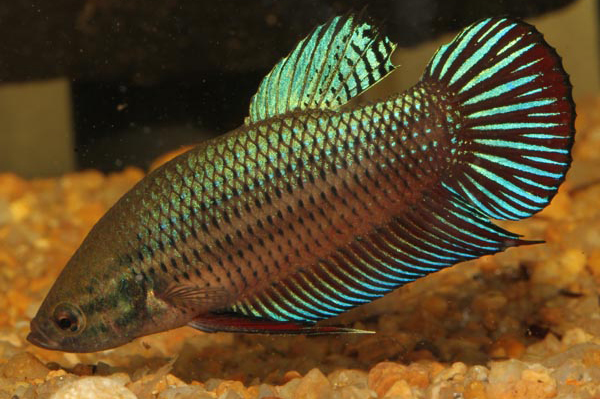Siamese Fighting Fish, Betta splendens Regan 1910

Siamese Fighting Fish, Betta splendens. Source: Dave Wilson / Aquagreen, http://www.aquagreen.com.au/. License: All rights reserved
A very popular aquarium fish known for its brilliant colours and elongate fins that have been developed through selective breeding in captivity. In the wild, Siamese Fighting Fish have relatively short fins and are a dull green, to brown or grey in colour. They are surface air breathers with a specialised labyrinth organ allowing them to gulp air from the surface and survive in waters that are low in dissolved oxygen.
The species was discovered in large numbers in Fogg Dam in the Northern Territory in January 2014. Although native to Thailand, Vietnam and Cambodia in Southeast Asia, introduced Siamese Fighting Fish are established in the wild in some parts of the world.
Siamese Fighting Fish may pose a significant threat to native fishes, frogs and other native species in these wetlands - through competition, predation and the introduction of diseases.
Siamese Fighting Fish, Betta splendens Regan 1910
More Info
|
Distribution |
Discovered in Fogg Dam and the Adelaide River Floodplain in the Northern Territory in January 2014. Native to Thailand, Vietnam and Cambodia in Southeast Asia. The species now appears widespread along the wetlands adjacent the Adelaide River on the Western side upstream and downstream of the Arnhem Highway. Siamese Fighting Fish are usually found around the margins of large, heavily vegetated marshes, rice paddies and slow moving streams. They can tolerate water with low dissolved oxygen levels due to air-breathing ability. |
|
Feeding |
Feeds mostly on small aquatic and terrestrial insects and larvae. |
|
Biology |
Males are very territorial and build a bubble nest into which females lay their eggs. He male guards to eggs, carefully ensuring that they remain in the bubble nest. The fry hatch after 24–36 hours, and remain in the nest for several days until they fully absorb their yolk sacs. The labyrinth organ develops and becomes functional after 3-6 weeks, and individuals may attain sexual maturity at 4-5 months. |
|
Species Citation |
Betta splendens Regan 1910, Proceedings of the Zoological Society of London 1909(4): 782. Type locality: Mae Nam Chao Phraya (as Menam River), Thailand. |
|
Author |
Bray, D.J. 2021 |
|
Resources |
Siamese Fighting Fish, Betta splendens Regan 1910
References
Baird, I.G., Inthaphaisy, V., Kisouvannalath, P., Phylavanh, B. & Mounsouphom, B. 1999. The fishes of southern Lao. Lao Community Fisheries and Dolphin Protection Project. Ministry of Agriculture and Forestry, Lao PDR.161 pp.
Brand, J.A., Martin, J.M., Tan, H. et al. 2021. Rapid shifts in behavioural traits during a recent fish invasion. Behavioural Ecology and Sociobiology 75: 134 https://doi.org/10.1007/s00265-021-03077-2
Chou, L.M. & Lam, T.L. 1989. Introduction of exotic aquatic species in Singapore. p. 91-97 in De Silva, S.S. (ed.) Exotic aquatic organisms in Asia. Proceedings of the Workshop on Introduction of Exotic Aquatic Organisms in Asia. Spec. Publ. Asian Fish. Soc. 3, 154 pp.
Courtenay, W.R., Jr. & Stauffer, J.R. Jr. 1990. The introduced fish problem and the aquarium fish industry. Journal of the World Aquaculture Society 21: 145-159.
Hammer, M.P., Skarlatos Simoes, M.N., Needham, E.W., Wilson, D.N., Barton, M.A. & Lonza, D. 2019. Establishment of Siamese fighting fish on the Adelaide river floodplain: the first serious invasive fish in the Northern Territory, Australia. Biological Invasions 21: 2269–2279. https://doi.org/10.1007/s10530-019-01981-3
Larson, H.K., Williams, R.S. & Hammer, M.P. 2013. An annotated checklist of the fishes of the Northern Territory, Australia. Zootaxa 3696(1): 1-293
Mohsin, A.K.M. & Ambak, M.A. 1983. Freshwater fishes of Peninsular Malaysia. Penerbit Universiti Pertanian Malaysia, Malaysia. 284 pp. Nico, L. 2012. Betta splendens. USGS Nonindigenous Aquatic Species Database, Gainesville, FL.
Rainboth, W.J. 1996. Fishes of the Cambodian Mekong. FAO Species Identification Field Guide for Fishery Purposes. FAO, Rome, 265 pp.
Rixon, C.A.M., Duggan, I.C., Bergeron, N.M.N., Ricciardi, A. & Macisaac, H.J. 2005. Invasion risks posed by the aquarium trade and live fish markets on the Laurentian Great Lakes. Biodiversity Conservation 14: 1365-1381.
Smith, H.M. 1945. The fresh-water fishes of Siam, or Thailand. United States Government Printing Office, Washington D.C.
Tan, H.H. & Ng, P.K.L. 2005. The fighting fishes (Teleostei: Osphronemidae: Genus Betta) of Singapore, Malaysia and Brunei. Raffles Bull. Zool. Supplement (13): 43-99.
Tan, H.H. & Ng, P.K.L. 2005. The labyrinth fishes (Teleostei: Anabantoidei, Channoidei) of Sumatra, Indonesia. Raffles Bull. Zool. Supplement (13): 115-138.
Vidthayanon, C. 2004. Handbook of freshwater fishes of Thailand. Sarakadee, Bangkok.
Welcomme, R.L. 1988. International introductions of inland aquatic species. FAO Fish. Tech. Pap. 294. 318 pp.



